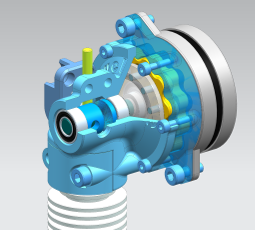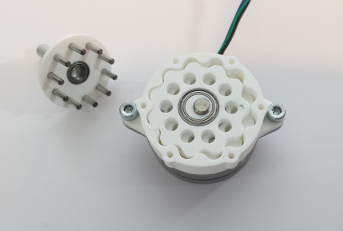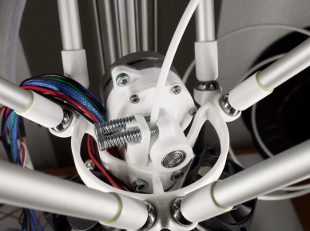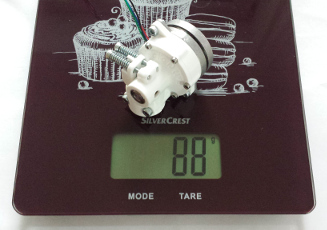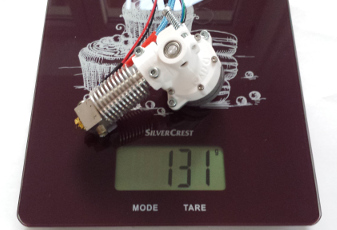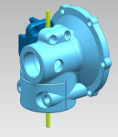This engineer claims 100 grams direct extruder. I want one
Posted by realthor
Re: This engineer claims 100 grams direct extruder. I want one May 06, 2016 04:14AM |
Registered: 9 years ago Posts: 483 |
Quote
ipcalit
Here is another idea inspired by these two:
1) thread the shaft of a tiny stepper (1-2Ncm is probably enough, <50g) with something between an M3-M5
2) make grooves with the corresponding tap (M3-M5) into the outside of a small bearing (e.g, 623, 624)
I doubt you would be able to use a tap as a hob on a bearing. The bearing will probably be harder then the tap
 You could hob a steel ring, then press the bearing into the ring.
You could hob a steel ring, then press the bearing into the ring.
Re: This engineer claims 100 grams direct extruder. I want one May 06, 2016 04:54AM |
Registered: 8 years ago Posts: 5,232 |
Quote
etfrench
Quote
ipcalit
Here is another idea inspired by these two:
1) thread the shaft of a tiny stepper (1-2Ncm is probably enough, <50g) with something between an M3-M5
2) make grooves with the corresponding tap (M3-M5) into the outside of a small bearing (e.g, 623, 624)
I doubt you would be able to use a tap as a hob on a bearing. The bearing will probably be harder then the tapYou could hob a steel ring, then press the bearing into the ring.
+1 about threading the bearing.
Also the circumfence of the bearing has to be an exact multiple of the thread pitch to provide smooth extraction.
I'm also in doubt that a thread would be a good filament guide. Wouldn't it push the filament in a diagonal/sideways direction?
There would be a lot of pressure necessary to keep the steppershaft meshed to the threaded bearing. Another idler/support bearing on the opposite side would help.
Like : o!O/O
Re: This engineer claims 100 grams direct extruder. I want one May 06, 2016 04:56AM |
Registered: 8 years ago Posts: 5,232 |
Quote
DjDemonD
I wonder if it would be possible to just stick a small stepper on the top of a flex3drive extruder, with its 40:1 reduction, especially for driving 1.75mm, it should need only a very small and light motor. I wonder if it would have sufficient power for a decent retract.
This motor [www.omc-stepperonline.com] can provide 7Ncm which into 40:1 (with no losses from the flexdrive itself), is only 50g making the complete extruder only 135g. Using a 13 Ncm nema 17 pancake with 3:1 gearing works extremely well on the titan so it should be powerful enough.
The stepper of a flex3drive is already in a remote position. What would the weight gain be good for?
Re: This engineer claims 100 grams direct extruder. I want one May 06, 2016 05:11AM |
Registered: 8 years ago Posts: 5,232 |
Quote
powdermetal
The Cycloidal Extruder Drive has been updated with a 16:1 ratio to engage the proposed lightweight NEMA14 pancake stepper 14HR08-0654S (7Ncm, 50g). This did work fine until the heat from the stepper made the PLA-components start to creep - will be resolved soon...
Would it help to add a heat barrier between stepper and gearbox? Like an airgap provided by epoxy/pertinax washers?
A clever airduct would suck air from around the stepper and guide it through the hotend-heatsink.
Edited 1 time(s). Last edit at 05/06/2016 05:14AM by o_lampe.
Re: This engineer claims 100 grams direct extruder. I want one May 06, 2016 08:04AM |
Registered: 8 years ago Posts: 3,525 |
Quote
o_lampe
The stepper of a flex3drive is already in a remote position. What would the weight gain be good for?
Cost! It's my understanding that a fair amount of the cost of the flex3drive system is the flexible drive itself. We are talking about making a lightweight direct extruder - flex3drive is that already and is lighter than anything we've discussed here - problem solved. So why the discussion at all, lets all buy flex3drive's and enjoy. I have got one Its really good. But its a little more expensive than any of the other extruders I've made/bought and its more complicated.
My thinking is that the worm gear in the flex3drive is a part you would have to buy, but you can print a housing and attach the 50g motor and you have a 135g direct extruder for a cost of $20-$30. The current flex3drive extruder minus the flexible drive is relatively cheap, already highly geared enabling use of light motors and its known to work.
Simon Khoury
Co-founder of [www.precisionpiezo.co.uk] Accurate, repeatable, versatile Z-Probes
Published:Inventions
Re: This engineer claims 100 grams direct extruder. I want one May 06, 2016 09:03AM |
Registered: 8 years ago Posts: 62 |
Quote
DjDemonD
Quote
o_lampe
The stepper of a flex3drive is already in a remote position. What would the weight gain be good for?
Cost! It's my understanding that a fair amount of the cost of the flex3drive system is the flexible drive itself. We are talking about making a lightweight direct extruder - flex3drive is that already and is lighter than anything we've discussed here - problem solved. So why the discussion at all, lets all buy flex3drive's and enjoy. I have got one Its really good. But its a little more expensive than any of the other extruders I've made/bought and its more complicated.
My thinking is that the worm gear in the flex3drive is a part you would have to buy, but you can print a housing and attach the 50g motor and you have a 135g direct extruder for a cost of $20-$30. The current flex3drive extruder minus the flexible drive is relatively cheap, already highly geared enabling use of light motors and its known to work.
See also chopmeister's NanoBlock extruder
Edited 1 time(s). Last edit at 05/06/2016 09:38AM by powdermetal.
Re: This engineer claims 100 grams direct extruder. I want one May 06, 2016 12:56PM |
Registered: 8 years ago Posts: 3,525 |
This looks good but it is more complicated than flex3drive despite doing the same thing. I agree with one of the comments above the fewer gears the better. One worm gear and one gear with a hobbed drive is all it needs.
Edited 1 time(s). Last edit at 05/06/2016 01:11PM by DjDemonD.
Simon Khoury
Co-founder of [www.precisionpiezo.co.uk] Accurate, repeatable, versatile Z-Probes
Published:Inventions
Edited 1 time(s). Last edit at 05/06/2016 01:11PM by DjDemonD.
Simon Khoury
Co-founder of [www.precisionpiezo.co.uk] Accurate, repeatable, versatile Z-Probes
Published:Inventions
Re: This engineer claims 100 grams direct extruder. I want one May 06, 2016 01:22PM |
Registered: 7 years ago Posts: 78 |
I agree with the challenge to machine threads into the bearing as it is a strong steel. The idea to add a sleeve out of steel or brass is probably better.
How about turning the flange of a largish bearing directly into a gear with some heavy duty cutting disk? That should be easier I think, and we could use either an M5/M6 to drive it or another smaller gear. If the cuts into the flange reach the outside diameter of the bearing then you get enough grooves to drive the filament. We would still need to find the right bearing diameter to match the screw threads. What do you think?
How about turning the flange of a largish bearing directly into a gear with some heavy duty cutting disk? That should be easier I think, and we could use either an M5/M6 to drive it or another smaller gear. If the cuts into the flange reach the outside diameter of the bearing then you get enough grooves to drive the filament. We would still need to find the right bearing diameter to match the screw threads. What do you think?
Quote
o_lampe
Quote
etfrench
Quote
ipcalit
Here is another idea inspired by these two:
1) thread the shaft of a tiny stepper (1-2Ncm is probably enough, <50g) with something between an M3-M5
2) make grooves with the corresponding tap (M3-M5) into the outside of a small bearing (e.g, 623, 624)
I doubt you would be able to use a tap as a hob on a bearing. The bearing will probably be harder then the tapYou could hob a steel ring, then press the bearing into the ring.
+1 about threading the bearing.
Also the circumfence of the bearing has to be an exact multiple of the thread pitch to provide smooth extraction.
I'm also in doubt that a thread would be a good filament guide. Wouldn't it push the filament in a diagonal/sideways direction?
There would be a lot of pressure necessary to keep the steppershaft meshed to the threaded bearing. Another idler/support bearing on the opposite side would help.
Like : o!O/O
|
Anonymous User
Re: This engineer claims 100 grams direct extruder. I want one May 09, 2016 08:22AM |
Quote
powdermetal
Quote
JamesK
Many thanks! My nema14 extruder with 5:1 ratio is right on the ragged edge for 3mm pla, so I'm looking for alternatives in the 10:1 ballpark. I may end up trying this
The Cycloidal Extruder Drive has been updated with a 16:1 ratio to engage the proposed lightweight NEMA14 pancake stepper 14HR08-0654S (7Ncm, 50g). This did work fine until the heat from the stepper made the PLA-components start to creep - will be resolved soon...
[attachment 77607 CycloExtruder_v02-2_small.png] [attachment 77608 CycloExtruder_v02-6_small.jpg]
I would like to know:
- At start, what torque do you measure at the hobbed gear, filament pulling force and at which intensity ?
- What printing speed can it achieve ?
- What about retraction speed ?
If the PLA softens, the motor may be driven outside of its specification. What t° did you measure ?
I was looking to replace the motor I took from a HP printer for this NEMA14, gaining a further 70g although so far, above 120mm/s the limiting factor I met is the hot end. SO change of priority.
|
Anonymous User
Re: This engineer claims 100 grams direct extruder. I want one May 09, 2016 09:55AM |
Quote
ipcalit
I agree with the challenge to machine threads into the bearing as it is a strong steel. The idea to add a sleeve out of steel or brass is probably better.
How about turning the flange of a largish bearing directly into a gear with some heavy duty cutting disk? That should be easier I think, and we could use either an M5/M6 to drive it or another smaller gear. If the cuts into the flange reach the outside diameter of the bearing then you get enough grooves to drive the filament. We would still need to find the right bearing diameter to match the screw threads. What do you think?
Quote
o_lampe
Quote
etfrench
Quote
ipcalit
Here is another idea inspired by these two:
1) thread the shaft of a tiny stepper (1-2Ncm is probably enough, <50g) with something between an M3-M5
2) make grooves with the corresponding tap (M3-M5) into the outside of a small bearing (e.g, 623, 624)
I doubt you would be able to use a tap as a hob on a bearing. The bearing will probably be harder then the tapYou could hob a steel ring, then press the bearing into the ring.
+1 about threading the bearing.
Also the circumfence of the bearing has to be an exact multiple of the thread pitch to provide smooth extraction.
I'm also in doubt that a thread would be a good filament guide. Wouldn't it push the filament in a diagonal/sideways direction?
There would be a lot of pressure necessary to keep the steppershaft meshed to the threaded bearing. Another idler/support bearing on the opposite side would help.
Like : o!O/O
What I think is simple:
Explain the "advantage" of this approach and to prove it, do it, then present it.
|
Anonymous User
Re: This engineer claims 100 grams direct extruder. I want one May 09, 2016 10:17AM |
Quote
DjDemonD
This looks good but it is more complicated than flex3drive despite doing the same thing. I agree with one of the comments above the fewer gears the better. One worm gear and one gear with a hobbed drive is all it needs.
My opinion too. I have looked at planetary gears, cycloidal gears too. When you need high reduction, minimal backlash, fine. Then I determined what gears ratio I needed to come to the conclusion that you don't need much in fact and just regular gears could do it. On the extruder, you need torque to drive the filament but rotation inversion, acceleration/speed to retract it ! High reduction will give you the torque but will the stepper be able to provide the required speed in reverse ?
The next real progress is Servo BLDC but not the same cost range.
But then it is the whole 3D printer that has to be revised.
The engineer who designed the printer with this 100gr extruder took the right approach. There is more in it than just the light weight extruder.
Re: This engineer claims 100 grams direct extruder. I want one May 09, 2016 10:23AM |
Registered: 8 years ago Posts: 3,525 |
My experience with the flex3drive is that it can do the necessary retraction, it just takes a fraction of a second to do it. I can retract 1.4mm @ 10mm/s with e-acceleration at 250. This does generate a noticeable pause, but no strings/blobs/ooze. I think it might even do better with a smaller motor. I think the 40mm motor I am using might be able to generate a lot of torque, but the extruder is 40:1 geared so it doesn't need to do so, it needs to change direction fast, so a smaller motor with less rotating mass, and lower detent torque to overcome might work better. I might experiment with some smaller motors, like the nema 17 - 20mm pancake.
Perhaps its just our current expectation of what retraction should be, will have to change for the sake of a lightweight extruder.
Edited 1 time(s). Last edit at 05/09/2016 10:26AM by DjDemonD.
Simon Khoury
Co-founder of [www.precisionpiezo.co.uk] Accurate, repeatable, versatile Z-Probes
Published:Inventions
Perhaps its just our current expectation of what retraction should be, will have to change for the sake of a lightweight extruder.
Edited 1 time(s). Last edit at 05/09/2016 10:26AM by DjDemonD.
Simon Khoury
Co-founder of [www.precisionpiezo.co.uk] Accurate, repeatable, versatile Z-Probes
Published:Inventions
|
Anonymous User
Re: This engineer claims 100 grams direct extruder. I want one May 09, 2016 10:47AM |
Quote
DjDemonD
My experience with the flex3drive is that it can do the necessary retraction, it just takes a fraction of a second to do it. I can retract 1.4mm @ 10mm/s with e-acceleration at 250. This does generate a noticeable pause, but no strings/blobs/ooze. I think it might even do better with a smaller motor. I think the 40mm motor I am using might be able to generate a lot of torque, but the extruder is 40:1 geared so it doesn't need to do so, it needs to change direction fast, so a smaller motor with less rotating mass, and lower detent torque to overcome might work better. I might experiment with some smaller motors, like the nema 17 - 20mm pancake.
Perhaps its just our current expectation of what retraction should be, will have to change for the sake of a lightweight extruder.
Initially, in fact before I new the flexdrive existed, I intended to do one using a flexible for Dremel plus planetary gears ... but finally preferred to go the lightweight direct extruder for a cartesian machine. Spline transmission axle and universal joints, combining guide rods and transmission using linear guides desinged for axial mvt and rotation could be options too.
Re: This engineer claims 100 grams direct extruder. I want one May 09, 2016 03:41PM |
Registered: 8 years ago Posts: 62 |
Quote
MKSA
Quote
powdermetal
Quote
JamesK
Many thanks! My nema14 extruder with 5:1 ratio is right on the ragged edge for 3mm pla, so I'm looking for alternatives in the 10:1 ballpark. I may end up trying this
The Cycloidal Extruder Drive has been updated with a 16:1 ratio to engage the proposed lightweight NEMA14 pancake stepper 14HR08-0654S (7Ncm, 50g). This did work fine until the heat from the stepper made the PLA-components start to creep - will be resolved soon...
[attachment 77607 CycloExtruder_v02-2_small.png] [attachment 77608 CycloExtruder_v02-6_small.jpg]
I would like to know:
- At start, what torque do you measure at the hobbed gear, filament pulling force and at which intensity ?
- What printing speed can it achieve ?
- What about retraction speed ?
If the PLA softens, the motor may be driven outside of its specification. What t° did you measure ?
I was looking to replace the motor I took from a HP printer for this NEMA14, gaining a further 70g although so far, above 120mm/s the limiting factor I met is the hot end. SO change of priority.
- Filament pulling force: Did not take any measurements - for the upcoming setup I'll try to get at least some data
- Printing speed: Up to 80mm/sec @ 0.2mm layer height @ 0.4mm nozzle, PLA, 210°C, motor current 0.45A (rated current is 0.50A), did not try to go higher
- Retraction: 5mm/s, 0.5mm, extruder_acceleration: 4000mm/s^2, retraction performance was not really tested, seems to work reasonable
- Motor temperature: Approx. 70°C (my finger's sensor...) - will do some measurements next time. 70°C makes PLA creep under mechanical load - so this was just a matter of time
Questions:
- Is there a simple way to measure torque?
- What do you mean exactly with "intensity"?
o_lampe's idea of using the airflow (intake or exhaust) from the hotend seems to be a smart approach...
Re: This engineer claims 100 grams direct extruder. I want one May 09, 2016 04:03PM |
Registered: 7 years ago Posts: 78 |
Agreed on the BLDC as the next step. Just performed some tests with a tiny precision geared DC motor and the 30g setup reaches 2.7Kg pull/push force from 4x AA batteries only. Seems to extrude PETG just fine through 0.4mm nozzle and the inertia is practically non-existent from such small motor.
Pairing a small 4 channel robot controller with a Raspberry Pi Zero and a couple of these small motors with different gearing ratios would make a neat printer. What do you think?
[robosavvy.com]
More details in this thread: [forums.reprap.org]
Pairing a small 4 channel robot controller with a Raspberry Pi Zero and a couple of these small motors with different gearing ratios would make a neat printer. What do you think?
[robosavvy.com]
More details in this thread: [forums.reprap.org]
Quote
MKSA
Quote
DjDemonD
This looks good but it is more complicated than flex3drive despite doing the same thing. I agree with one of the comments above the fewer gears the better. One worm gear and one gear with a hobbed drive is all it needs.
My opinion too. I have looked at planetary gears, cycloidal gears too. When you need high reduction, minimal backlash, fine. Then I determined what gears ratio I needed to come to the conclusion that you don't need much in fact and just regular gears could do it. On the extruder, you need torque to drive the filament but rotation inversion, acceleration/speed to retract it ! High reduction will give you the torque but will the stepper be able to provide the required speed in reverse ?
The next real progress is Servo BLDC but not the same cost range.
But then it is the whole 3D printer that has to be revised.
The engineer who designed the printer with this 100gr extruder took the right approach. There is more in it than just the light weight extruder.
Re: This engineer claims 100 grams direct extruder. I want one May 09, 2016 08:01PM |
Registered: 9 years ago Posts: 425 |
Quote
DjDemonD
My experience with the flex3drive is that it can do the necessary retraction, it just takes a fraction of a second to do it. I can retract 1.4mm @ 10mm/s with e-acceleration at 250. This does generate a noticeable pause, but no strings/blobs/ooze. I think it might even do better with a smaller motor. I think the 40mm motor I am using might be able to generate a lot of torque, but the extruder is 40:1 geared so it doesn't need to do so, it needs to change direction fast, so a smaller motor with less rotating mass, and lower detent torque to overcome might work better. I might experiment with some smaller motors, like the nema 17 - 20mm pancake.
Perhaps its just our current expectation of what retraction should be, will have to change for the sake of a lightweight extruder.
1. Drop your retract accel to 75-100mms and your E Axis accel to 75-100mms (unretract uses normal E axis accel)
2. Drop your E axis vref quite low, mine is set to 0.25v on a normal 4988 driver with 1.8amp motor.
3. Increase the retract speed in your slicer
Doing the above might sound like it will slow things down however it will in fact give you very snappy and relibale retracts.
You may have to play around a little with those numbers but heading in that direction will give you much better results.
Too high a vref seems to leave too much residual current in the driver circuit/motor windings leading to stalls during retract.
PM me if you want more guidance or find me in #reprap to discuss/fine tune
Re: This engineer claims 100 grams direct extruder. I want one May 17, 2016 10:53AM |
Registered: 9 years ago Posts: 54 |
Re: This engineer claims 100 grams direct extruder. I want one June 04, 2016 05:25PM |
Registered: 8 years ago Posts: 62 |
The Cycloidal Extruder Drive has been updated to solve some previous issues:
- v0.3 was made from a more temperature resistant material and includes an air duct to cool the stepper motor from the hot end's exhaust -> has survived several longer test prints
- For better print quality, the tolerance stack-up has been reworked, gear profile clearance has been tightened -> shows some positive results
- Gear ratio was designed to 12:1 -> works stable for printing, but skipping steps when manually extruding material, next build will be 16:1 again...
Edited 1 time(s). Last edit at 06/04/2016 05:30PM by powdermetal.
- v0.3 was made from a more temperature resistant material and includes an air duct to cool the stepper motor from the hot end's exhaust -> has survived several longer test prints
- For better print quality, the tolerance stack-up has been reworked, gear profile clearance has been tightened -> shows some positive results
- Gear ratio was designed to 12:1 -> works stable for printing, but skipping steps when manually extruding material, next build will be 16:1 again...
Edited 1 time(s). Last edit at 06/04/2016 05:30PM by powdermetal.
Re: This engineer claims 100 grams direct extruder. I want one June 06, 2016 07:01AM |
Registered: 12 years ago Posts: 799 |
Wow thats looking awsome 
whats the overall weight of the Extruder part with/without hotend ?
What E-Steps do you have with this ?
 Chri
Chri
[chrisu02.wordpress.com] Quadmax Intel Delid Tools

whats the overall weight of the Extruder part with/without hotend ?
What E-Steps do you have with this ?
 Chri
Chri[chrisu02.wordpress.com] Quadmax Intel Delid Tools
Re: This engineer claims 100 grams direct extruder. I want one June 09, 2016 03:32PM |
Registered: 8 years ago Posts: 62 |
Quote
Chri
Wow thats looking awsome
whats the overall weight of the Extruder part with/without hotend ?
What E-Steps do you have with this ?
Chri
Weight:
- Stepper motor + drive unit: 88g
- Stepper motor + drive unit + hotend: 131g
E-Steps: 7000/mm (400 steps/rev * 32 microsteps / 21 mm/rev * i=12:1 -> 7.314 steps per mm)
Note: 32 microsteps do not really make sense - I just won't reconfig my board everytime the extruder is switched over for testing.
Edited 2 time(s). Last edit at 06/09/2016 03:38PM by powdermetal.
Re: This engineer claims 100 grams direct extruder. I want one June 13, 2016 07:17AM |
Registered: 9 years ago Posts: 193 |
Re: This engineer claims 100 grams direct extruder. I want one June 13, 2016 07:30AM |
Registered: 8 years ago Posts: 3,525 |
Yeah I'd say there is a lot to be said for looking at 1.75mm as it does not require as much force to push through the hot end, therefore lowering the bar on making a lightweight extruder. Respect for doing this with 3mm it is a greater challenge but I run my corexy and delta on 1.75mm so I can have a lighter extruder.
Plus 1.75mm runs off the spool better
Simon Khoury
Co-founder of [www.precisionpiezo.co.uk] Accurate, repeatable, versatile Z-Probes
Published:Inventions
Plus 1.75mm runs off the spool better

Simon Khoury
Co-founder of [www.precisionpiezo.co.uk] Accurate, repeatable, versatile Z-Probes
Published:Inventions
Re: This engineer claims 100 grams direct extruder. I want one June 13, 2016 02:56PM |
Registered: 8 years ago Posts: 62 |
Quote
Curry44
Great project!
Whats with supporting 1,75mm filament?
greets from Germany
Quote
DjDemonD
Yeah I'd say there is a lot to be said for looking at 1.75mm as it does not require as much force to push through the hot end, therefore lowering the bar on making a lightweight extruder. Respect for doing this with 3mm it is a greater challenge but I run my corexy and delta on 1.75mm so I can have a lighter extruder.
Plus 1.75mm runs off the spool better
Everything what DjDemonD said is fully correct - 1.75mm has a lot of benefits and many new printer designs start with this diameter.
When time has come (and when this thing has a proven track of robustness), there maybe a 1.75mm version as well - for the time being, it is highly experimental...
However, why deal with simpler things when there are much more challenging ones to tackle ?

PS: Greetings from Germany as well.
Edited 2 time(s). Last edit at 06/13/2016 03:32PM by powdermetal.
Re: This engineer claims 100 grams direct extruder. I want one June 14, 2016 02:22AM |
Registered: 9 years ago Posts: 1,035 |
The 12:1 you use now would be more than enough for the 1.75mm filament, what changes are necessary to make it 1.75mm compatible?
RepRap Lander concept on Concept Forge
RepRap Lander concept on RepRap Forums
My Things, mostly experimental stuff
RepRap Lander concept on Concept Forge
RepRap Lander concept on RepRap Forums
My Things, mostly experimental stuff
Re: This engineer claims 100 grams direct extruder. I want one June 14, 2016 02:23PM |
Registered: 8 years ago Posts: 62 |
Quote
realthor
The 12:1 you use now would be more than enough for the 1.75mm filament, what changes are necessary to make it 1.75mm compatible?
The only things you will need to update are the flanged block, which sits on top of the hotend and the idler holder:
The required files are attached - please send me a PM if you have any questions or comments and let us know your results!
Re: This engineer claims 100 grams direct extruder. I want one June 15, 2016 09:51AM |
Registered: 9 years ago Posts: 193 |
Re: This engineer claims 100 grams direct extruder. I want one June 17, 2016 08:58AM |
Registered: 8 years ago Posts: 93 |
Re: This engineer claims 100 grams direct extruder. I want one June 17, 2016 09:23AM |
Registered: 8 years ago Posts: 5,232 |
Quote
asbo
@powdermetal
Are you modelling your CycloidalExtruderDrive in SolidWorks? If so could you upload the native SolidWorks files as both the 3mm step files from the wiki and the 1.75mm ones above throw up all sorts of errors for me.
Thanks
I had the same issue when converting the .stp files to .stl with the ABViewer.
I took netFabb to repair the parts, but stil got errors shown, but now Cura can slice them perfectly.
Printing the excenter is a different story

Re: This engineer claims 100 grams direct extruder. I want one June 17, 2016 12:47PM |
Registered: 8 years ago Posts: 62 |
Quote
o_lampe
Quote
asbo
@powdermetal
Are you modelling your CycloidalExtruderDrive in SolidWorks? If so could you upload the native SolidWorks files as both the 3mm step files from the wiki and the 1.75mm ones above throw up all sorts of errors for me.
Thanks
I had the same issue when converting the .stp files to .stl with the ABViewer.
I took netFabb to repair the parts, but stil got errors shown, but now Cura can slice them perfectly.
Printing the excenter is a different story
The design is made with NX. STEP and Parasolid are from experience the only useful options for exporting geometry I can offer.
There seem to be a lot of issues in CAD interfaces when going to the details, even with standardized formats like IGES and STEP. Most times this is related to weak implementations of translators or related to problems when importing to the kernel of the target system. Professional translators do a careful analysis of the geometric entities, throw a bunch of detailed messages and fix any imperfections.
If it helps, please send a PM and I will provide STL-files.
Re: This engineer claims 100 grams direct extruder. I want one June 17, 2016 12:53PM |
Registered: 9 years ago Posts: 193 |
Sorry, only registered users may post in this forum.
